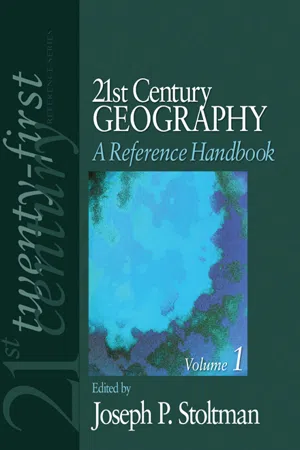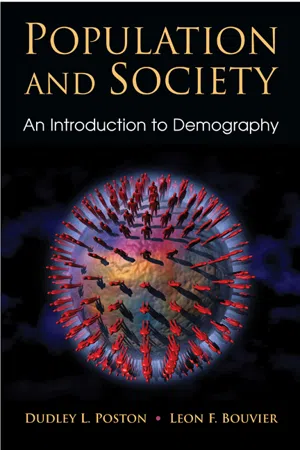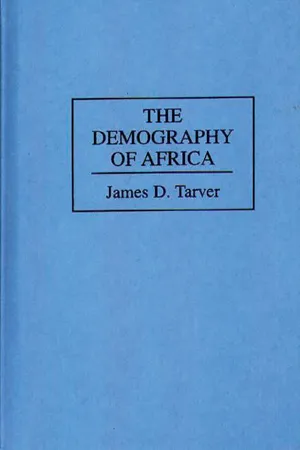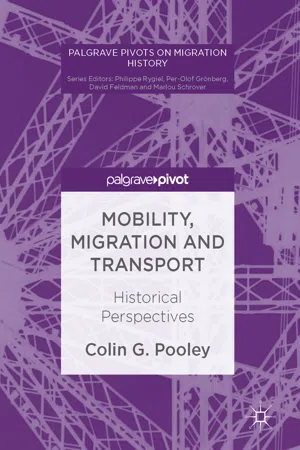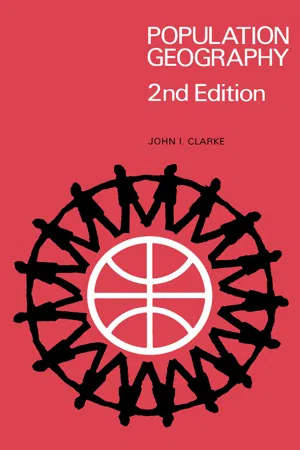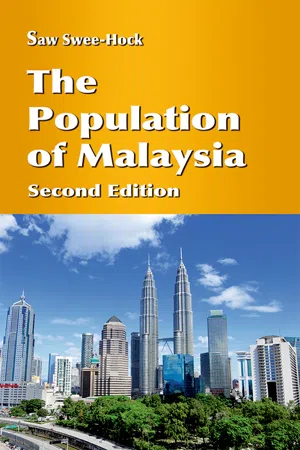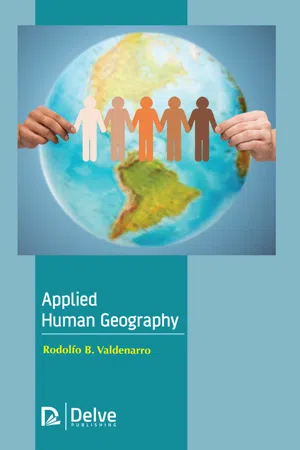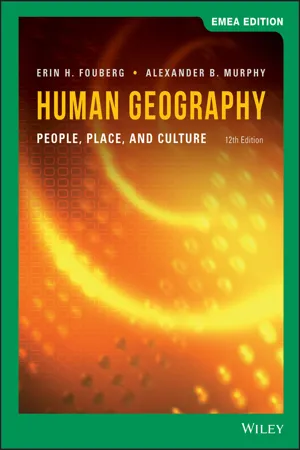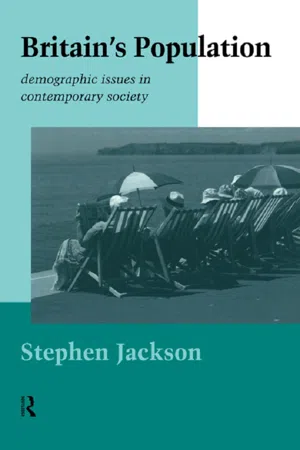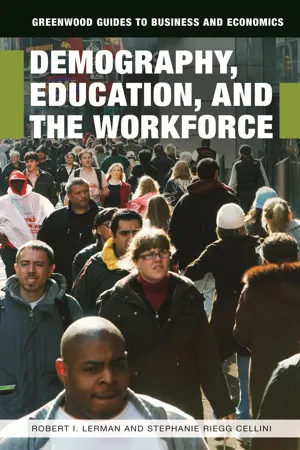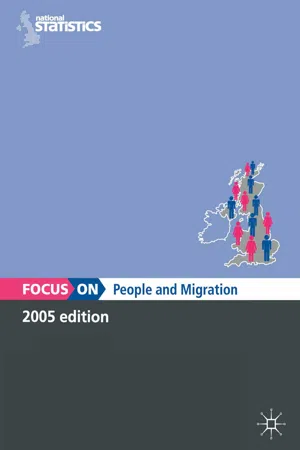Geography
Internal Migration
Internal migration refers to the movement of people within a country, typically from rural to urban areas or between different regions. It is driven by factors such as employment opportunities, better living conditions, and access to services. Internal migration can have significant impacts on population distribution, urbanization, and regional development within a country.
Written by Perlego with AI-assistance
Related key terms
1 of 5
12 Key excerpts on "Internal Migration"
- eBook - PDF
- Joseph P. Stoltman(Author)
- 2011(Publication Date)
- SAGE Publications, Inc(Publisher)
Migration involves people leaving a place (origin) and arriving at a new place (destination) under varying circum- stances. Migration is not pursued in isolation because the decision to migrate is linked to numerous push and pull factors. If City A has 30% unemployment and City B has a 5% or lower unemployment rate, it seems apparent that the economic hardship would act as the push factor to encourage people to leave City A and the opportunity (low unemployment rate) would act as the factor pulling people toward City B. There are intervening obstacles, which may impede migration, and that discussion is presented later in the chapter. Wherever there are movements of people, there are consequent demographic, social, and economic changes with spatial implications. Geographers study the spatial nature of movement and seek to derive the motives that people have for moving. The geographic contexts for 231 232 • HUMAN GEOGRAPHY migration occurs in multiple forms, such as people fleeing regions experiencing military conflicts, land-poor people settling new lands that are available for agriculture, or the mass migrations of Europeans moving to the Americas during times of religious, economic, and political repres- sion. These movements represent humans' quest for new beginnings and illustrate the migration phenomenon and restructuring of populated places in the world. Geography as a spatial discipline synthesizes and analyzes migration at different scales in the context of a place of origin and a place of destination. What Is Migration? What is migration? It can be defined spatially, based on where and how long individuals change their residential address domestically or internationally. Is the move perma- nent or semipermanent? Is it migration if a person moves from downtown Los Angeles to Hollywood? How about Mr. - eBook - PDF
Population and Society
An Introduction to Demography
- Dudley L. Poston, Jr., Leon F. Bouvier(Authors)
- 2010(Publication Date)
- Cambridge University Press(Publisher)
The U.S. Bureau of the Census defines migration occurring within the United States as “a move that crosses jurisdictional boundaries. Local moves – for instance, those within a county, are considered resi- dential mobility” (2006: 1). The definition of an internal migrant as one whose change in residence involves moving from one county to another is 166 167 Internal Migration generally the definition used worldwide; any persons who change residence by moving from one county (or county-type unit) to another is a migrant. Bear in mind that all migrants are movers, but all movers are not necessarily migrants. Virtually all of us, at least one time in our lives, will be migrants. And usually this happens early in our lives, not later. In modern industrialized countries such as the United States, nearly everyone experiences migration. Since the 1970s, we authors of this text have been teaching demography courses to undergraduate and graduate students in a half-dozen different universities. Of the many thousands of students we have taught, we have found that fewer than a dozen had not yet migrated by the time they took our courses. And, if we broaden the concern from migration to residential mobility, the two of us can remember teaching only a couple of students who had never ever moved; that is, they had never moved from the homes in which they lived as infants. Residential mobility and migration affect and will continue to affect virtually all of us. Migration is a significant event not only for persons but for communi- ties as well. Migration from one area to another has the effect of decreasing the size of the population in the area of origin and increasing it in the area of destination. Concerning the dynamics of population growth for commu- nities, Internal Migration is the single most important of the three demo- graphic processes (i.e., fertility, mortality, and migration). - eBook - PDF
- Bloomsbury Publishing(Author)
- 1996(Publication Date)
- Praeger(Publisher)
Thus, many previously used definitions of migrants have been somewhat arbitrary. 118 The Demography of Africa Obviously, geographic mobility involves changes in the residences of people and may or may not involve social mobility. Regardless, political and administrative units of countries provide a basis for classifying residential movers. A person whose move is within a census district is identified as a local mover, whereas one who moves from one district to another within that country is classified as an internal migrant, not a local mover. The practice is to count as movers only those persons whose residences are different at the beginning and end of the period. Movers who died during the period are excluded as well as those who moved and then returned to their previous residence. A number of factors, of course, affect the rates of internal movement, including the numbers, sizes, and shapes of the political units in each country. For example, countries with relatively few districts, reasonably square in shape, tend to have comparatively small numbers of internal migrants, other things being equal. In contrast, countries with numerous districts, narrow and elongated in shape, usually have relatively large numbers of internal migrants. The number of internal migrants for a geographic area always refers to movement during a specified period of time. For example, population censuses and surveys sometime ask a question for a person's residence one year ago, five years ago, or perhaps even the place of birth of individuals. In any event, as the duration of residence lengthens both the number of migrants and the rate of migration increases. Most Internal Migration data for African countries come from population censuses and surveys, being based upon questions either about place of previous residence or place of birth. - eBook - PDF
Mobility, Migration and Transport
Historical Perspectives
- Colin G. Pooley(Author)
- 2017(Publication Date)
- Palgrave Macmillan(Publisher)
Most people will move home within their country of residence many times during a life time, but many will never relocate internationally and if they do it may be a once in a lifetime event. In this section I briefly outline some of the main research foci within the study of internal migra- tion, and argue that in some cases at least an internal move may be just as difficult and disruptive as an international move. I also seek to demonstrate that an approach to the study of Internal Migration through mobilities theories is both feasible (arguably easier than for much international migration) and desirable. In almost all parts of the world research on Internal Migration has focused on its links to economic and urban development and, especially, on the process and impacts of rural to urban migration during periods of industrialisation and urbanisation (Mabogunje 1970; Lawton 1973; Moch 1983; Hoschstadt 1999; Bras 2003; Zhang and Shunfeng 2003). Although experienced at very different times in various parts of the world this is a process that almost all societies have undergone at some point in their history. It is also a process that many of the most rapidly growing economies of the world are still undergoing. The extent to which a complete picture of Internal Migration can be gained depends very much on the sources that are available. Where population registers provide a longitudinal picture (as in much of continental Europe) it is possible to 28 C.G. POOLEY place rural to urban moves within the broader context of migration over the whole life course (Adams et al. 2002; Kok 2004), however where the main source of data comes from census birthplace information (as in Britain) this is not possible unless longitudinal records are created through the linkage of a range of sources (Pooley and Turnbull 1998; Long 2005). - eBook - PDF
Population Geography
Pergamon Oxford Geographies
- John I. Clarke, W. B. Fisher(Authors)
- 2013(Publication Date)
- Pergamon(Publisher)
It is not surprising that there is a growing tendency to consider migrations as either internal (within a state) or external (international). This approach has been induced by the great significance of state boundaries and the availabiUty of data at the state level. Such a simple distinction cannot satisfy geographers who are interested not merely in numerical gains and losses due to migrations and their demographic, social and economic eflects, but also in environmental influences upon migration streams and consequences in areas of departure and destination. It would be unwise to consider that internal and external migrations are entirely different in causes, characteristics and consequences, though they 130 Migrations 131 have influenced terminology. By emigration and immigration we mean departure from or entry into a state for the purpose of changing residence. These are usually termed permanent when the residence is for more than one year, and temporary when it is for less. The distinction between a temporary inmiigrant and a visitor is clear in theory but not in practice, for a visitor may be defined as a non-resident intending to remain for one year or less without engaging in an occupation within the country. But the intention as to the duration of migration may change on arrival. George has also noted various confusions in the terms emigration and inMnigration, which do not include, for example, migrations to and from colonial territories or between national groups within one state. When we are considering Internal Migrations, the equivalent terms of emigration and inunigration are out(ward)-niigration and in(ward)-migration. Net external or Internal Migration is merely the balance and is often only a small fraction of gross migration, to which it may bear httle relation. Migration rates relate the number of migrants to the population exposed to the likehhood of migrating, and may be specific for age and sex. - eBook - PDF
- Saw Swee-Hock(Author)
- 2015(Publication Date)
- ISEAS Publishing(Publisher)
43 3 Internal Migration The movement of people within Malaysia has assumed greater significance as a result of the official concern about the unbalanced distribution of the population among the various parts of the country. This concern was explicitly expressed in the development plans adopted from the early 1970s onwards, and specific strategies were spelled out to, among other things, redistribute the population. The plans seek to distribute the population to sparsely settled rural areas with agricultural potential, to spread out the urban population more evenly throughout the country, and to rearrange the population with the view of attaining greater economic balance among the major communities. The underlying purpose of the last strategy as stated in the Third Malaysia Plan was to free the Bumiputera from their despondence on subsistence agriculture and to allow them to participate in the “modern rural and urban sectors of the economy at all levels”. 1 In fact, the Second Malaysia Plan has spelled out the overall aim of the population policies was meant to achieve “economic balance between urban and rural areas and to eliminate the identification of race with vocation as well as location”. 2 Internal Migration may be defined as a change of residence from one community or geographical unit to another within the national boundaries. The movement of people within the country can be examined in terms of the following categories: 1. Migration among the thirteen states, known as inter-state migration. 2. Migration among the various districts within a particular state. This is known as intra-state migration at the district level. 3. Migration among different urban and rural areas. This can be classified into urban-urban, urban-rural, rural-urban, and rural- rural. 44 POPULATION OF MALAYSIA An urban area is defined as a conurbation with 10,000 or more inhabitants. 3 The rural-urban type of movement is more commonly known as urbanization. - eBook - PDF
- Rodolfo B. Valdenarro(Author)
- 2019(Publication Date)
- Delve Publishing(Publisher)
When the new transient arrives, it is simpler to get settled in, to comprehend the traditions of the new spot, and to look for some kind of employment on the off chance that they definitely know individuals in the spot they settle. Relocation is a ceaseless procedure that has been the subject of political discussion around the world. Movement has demonstrated a solid upward pattern, be it of individuals who have left their countries intentionally for financial or different reasons, or of the individuals who have been driven away from their homes (outcasts, dislodged people, and so forth.). Overseeing human portability is one of the best difficulties for goal nations around the world, in created and creating nations. 9.2. TYPES OF MIGRATION Relocation can be grouped in a few different ways. It is typically arranged as in the subsection. 9.2.1. By Political Limits In view of political points of confinement and the limits crossed, for example, locale, districts, state outskirts and worldwide limits, further recognized as the spots of source and goal. A broadly perceived qualification exists among interior and global relocation: 1. Internal Migration Movement happening inside a nation from intersection political limits, either inside a state or between states, regardless of whether urban to rustic, urban to urban, provincial to country, or country to urban. The term related with vagrants touching base at their goal is “in-transients,” and with those leaving Applied Human Geography 188 their place of source is “out-vagrants.” This type of relocation likewise incorporates development between towns, squares and locale. 2. International migration Movement happening crosswise over nation limits. Such vagrants are known as outsiders (coming into a remote nation) and wanderers (leaving their own nation). This additionally incorporates mainland to-landmass relocation. - eBook - PDF
Albania on the Move
Links between Internal and International Migration
- Julie Vullnetari(Author)
- 2012(Publication Date)
- Amsterdam University Press(Publisher)
access to agricultural land. Movement without a hukou was highly restricted until the mid-1980s; since then, movement has been possible, although settlement still remains a problem (UNDP 2009: 52). One conse-quence is the structural segmentation in urban areas, especially of the labour market, between migrants in possession of required permits and ‘ ir-regular ’ ones, the latter known as the ‘ floating population ’ . They cannot get stable, highly paid and skilled jobs, and lack the rights to health care, education and housing associated with urban citizenship (Chan 1999; Li 2004: 681). Internal Migration thus becomes comparable to international flows not only in terms of legal and other associated barriers, but also in terms of outcomes (Davin 1999). These situations are not static, however, as historical and political factors intertwine to change the context. For instance, in the first example above, changing political factors resulted in freedom of movement within South Africa. In other instances, such as in parts of Africa or Asia, pre-colonial movements could be defined as internal, based on ethnic and tribal affilia-tions within the wider continental territories. Following the post-colonial independent state formation from the early 1960s, some of these move-ments became international and subject to immigration regulations (Adepoju 1998; Lyons & Ford 2007). A similar outcome can be noted for peoples from the Former Soviet Union after its break-up into independent republics at the end of the Cold War. The opposite, i.e. international move-ments becoming internal, may also be the case, as in the reunification of East and West Germany around the same time period. Even across clearly delineated de jure country borders, many interna-tional movements – often irregular – may resemble, for all intents and pur-poses, Internal Migrations. - eBook - PDF
Human Geography
People, Place, and Culture
- Erin H. Fouberg, Alexander B. Murphy(Authors)
- 2020(Publication Date)
- Wiley(Publisher)
Most are migrants who reported average salaries of less than $150 a month. This chapter explores why people migrate, whether by force or voluntarily. We discuss where people migrate, both within countries and across country borders, and how governments impact migration. CHAPTER OUTLINE 3.1 Explain migration as a type of movement. • Cyclic Movement • Migration 3.2 Explain Historic and Modern Forced Migration. • Historic Forced Migration • Modern Slavery and Human Trafficking 3.3 Explain the Theories of Migration and Understand the Motivations for Migration. • Laws of Migration and the Gravity Model • Push and Pull Factors 3.4 Identify why refugees are a distinct group of migrants and describe where most refugees migrate. • Distribution of Refugees • Areas of Dislocation 3.5 Determine how government policies impact migration. • Waves of Immigration in the United States • Legal Restrictions Photo by A.B. Murphy. © 2020 John Wiley & Sons, Inc. FIGURE 3.1 Mumbai, India. A view from the top of a high-rise in the central city, looking at one of the slums found tucked between buildings throughout the city. The Census of India reports that more than 50 percent of the Mumbai’s residents live in slums. 3.1 Explain Migration as a Type of Movement 63 Migration is a type of movement that changes both the places migrants leave and the places they go. The movement of peo- ple along paths of migration creates connections and networks among places. Migration changes how people see themselves and others. It also increases spatial interaction and speeds the diffusion of ideas and innovations among places connected through migration. Geographers identify two basic types of movement. Leav- ing home for a defined amount of time and returning home is called cyclic movement. Migration changes the location of home and has a degree of permanence not found in cyclic movement. Migration is movement from a home location to a new place with an intent to stay in the new place permanently. - eBook - ePub
Britain's Population
Demographic Issues in Contemporary Society
- Steven Jackson(Author)
- 2013(Publication Date)
- Routledge(Publisher)
Other factors which influence patterns of inter-regional movement include population structure. Life-cycle stage is significant in determining who will move and when. A significant amount of migration occurs at ‘transitional’ phases in people’s lives – particularly at the transition between education and employment and the transition between employment and retirement. Young adults are the most mobile group in the population, not only because of the diverse opportunities available for entry into the labour market, but also because of their general lack of commitments of home ownership and family rearing. As a consequence growth regions tend to attract a disproportionate share of young adults, and localities which are losing numbers become unbalanced in their structure. The destinations for retirement migrants similarly reflect the effects of age-specific migration, with an increasing burden placed on the health and social services for the care of an ageing population.Intra-regional mobility
Patterns of population movement between the regions may reflect the longerterm process of population redistribution in Britain. However, the majority of moves are over relatively short distances. Over 70 per cent of moves in Britain are over distances of 10 km or less – most of which would come under the heading of residential relocation rather than migration (Owen and Green 1991). People move house for a variety of reasons, depending on individual circumstances, but it is possible to identify aggregate patterns of movement from the overall volatility of local moves. One of the wellestablished trends is the process of ‘suburbanization’, brought about by a constant drift of population from the central areas of towns and cities towards newer housing developments on the periphery. This is not a new process and can be identified in Britain from the peak period of urban growth in the nineteenth century. - eBook - PDF
- Robert I. Lerman, Stephanie Riegg Cellini(Authors)
- 2009(Publication Date)
- Greenwood(Publisher)
In the United States, international immigrants might move into areas with plentiful job opportunities, thereby discouraging U.S. residents from moving into the same areas. Indeed, some researchers (Borjas 2000) have argued that met- ropolitan areas that attract foreign immigrants experience more outflows and fewer inflows of native workers. However, other researchers (Wright, Ellis, and Reibel 1997) find that additional foreign migrants to a metropolitan area do not discourage U.S. residents from migrating to and staying in the same metropoli- tan area. We discuss this issue and its implications in detail in Chapter 4. Between 2005 and 2006, 13.7 million U.S. residents moved to another county and almost 25 million residents moved within the same county. Nearly one-third, or 4.3 million peo- ple, move for job-related reasons. This figure represents only about 3 percent of the workforce, but almost 3 times the aver- age increase in the labor force between 2001 and 2007. Thus, annual Internal Migration can quickly redistribute the U.S. workforce from high to low unemployment areas. The annual flows of workers from one county to another county cumulate and in three years may reach 10 percent or more of the workforce. In principle, Internal Migration is of a scale that can substan- tially lower the dispersion in unemployment rates across states. To illustrate, let us calculate the cumulative sum of all unem- ployment workers in each state in excess of 4.9 percent (approxi- mately the average in April 2007). Put another way, how many unemployed workers in all the states with high unemployment rates would have to migrate to bring all of these state unemploy- ment rates down to 4.9 percent? In April 2008, the figure was about 580,000. By contrast, about 1.9 million people moved 126 Demography, Education, and the Workforce from one state to another for job-related reasons. No doubt, much of the existing migration already lowered the dispersion of unemployment rates. - eBook - PDF
- NA NA(Author)
- 2016(Publication Date)
- Palgrave Macmillan(Publisher)
These include much of Northern Ireland (especially the more rural west), northern Scotland (especially the Shetlands and Eilean Siar), the Glasgow area and south-west Scotland, several of the larger English cities (including Liverpool and Birmingham) and many of the older industrial towns. Rather less expected is the way in which London's overwhelming picture of net migration loss (all except the City of London, Kingston upon Thames, and Lambeth) extends out deep into the Home Counties and indeed south into East Sussex and west into Wiltshire. This must be due largely to the tightness of the housing market in this broad zone, especially around that time as the 'house price ripple' of the late 1990s economic boom moved further out from London. The high net-loss outliers in rural West Oxfordshire and North Yorkshire are likely due to movements of military personnel. Table6.14 Chapter 6: Population movement within the UK Geographical patterns of migration for selected types of people As shown earlier, migration can be a very selective process, involving some types of people much more than others. Differences in the characteristics of those moving in and those moving out can have a significant impact on the population composition of individual places. Chapter 2 describes many of the geographical variations in population characteristics that arise from Internal Migration and other factors. This chapter describes in further detail the geographical patterns of Internal Migration relating to four selected characteristics. Age One of the most important features of migration patterns by age is the difference by settlement size. Migration data from the 2001 Census support the assertion that young adults seek out the 'bright city lights' and show that families with children and older people are more likely to move out of large cities than to move to them.
Index pages curate the most relevant extracts from our library of academic textbooks. They’ve been created using an in-house natural language model (NLM), each adding context and meaning to key research topics.
